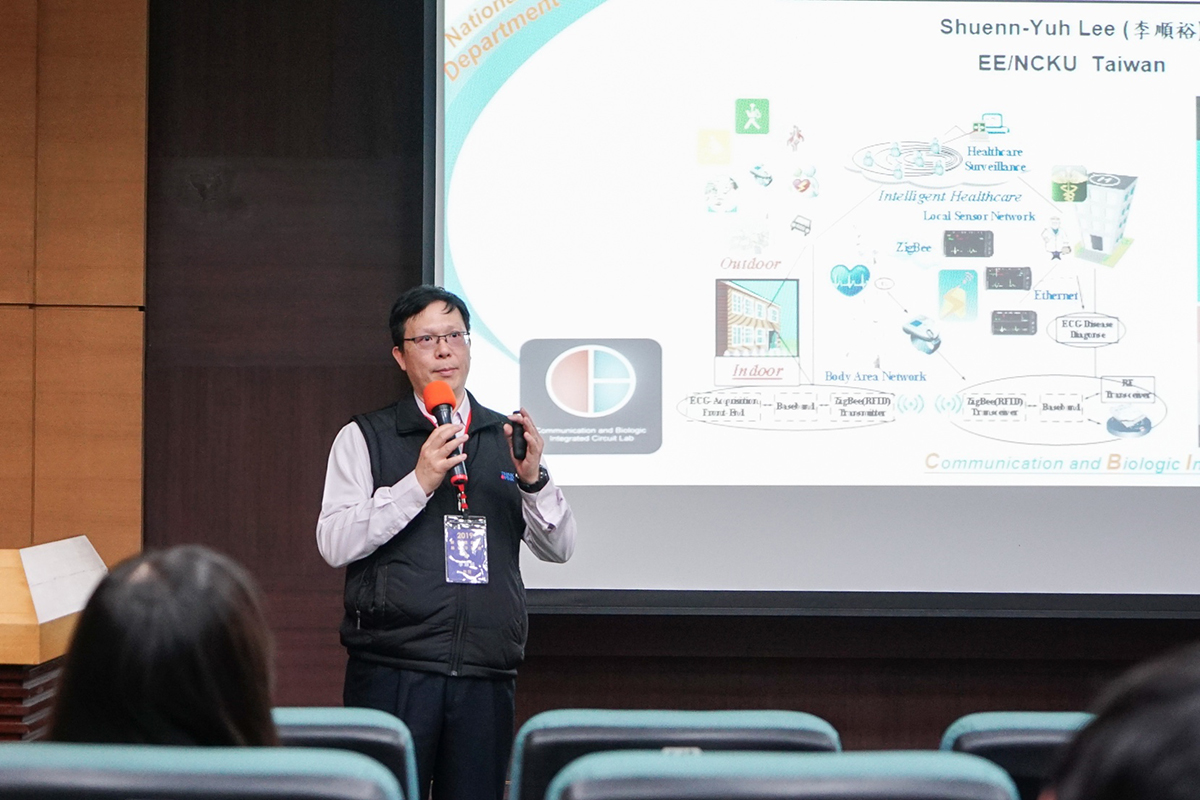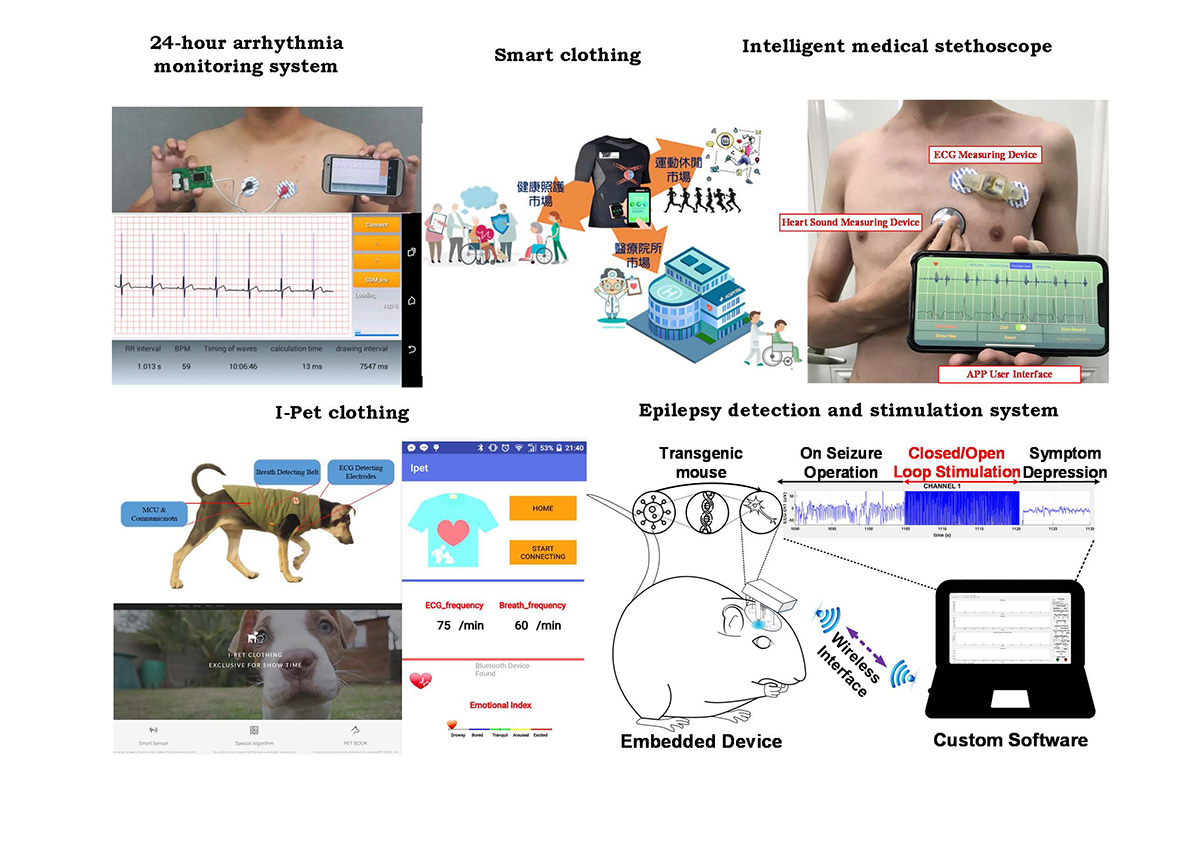Professor Shuenn-Yuh Lee, National Cheng Kung University, discusses his mission to build a user-friendly development platform with smart wearable technology, in this report
I established the Communication and Biologic Integrated Circuit (CBIC) Lab in 2002. My mission is to build a user-friendly development platform with smart wearable systems, which consists of the biosignal processing integrated circuits and modules, the user-friendly websites and apps, and the artificial intelligence (AI) system on the cloud.
The goal of the Guard Patch is to develop a Low-power Long-term Wearable Body Sensor SOC for Wireless Electrocardiogram Monitor. Our team designs and implements a high resolution and low power bio-signal acquisition chip. The chip is fabricated in a TSMC 0.18 μm standard CMOS process. Based on this chip, we integrate the required circuits into a wearable system module to sense the Electrocardiography (ECG) signal from users. The communication between the sensor and the smartphone is established via Bluetooth.
The software needs to fulfil the following four principal tasks: 1) data processing 2) analysing, 3) displaying, and 4) recording. A back-end application (APP) on Android/iOS system carries out further mathematical calculation and analysis, including demodulation and digital signal processing. With the basic monitor function (off-line bio-signal data storage), the real-time monitoring function is also developed and the real-time bio-signal can be checked on the smart device.
The processed ECG signal will then be displayed on the screen. With such a wearable platform for wireless bio-signal acquisition, the user can access and monitor his own physiological condition anytime and anywhere.
For these functions mentioned above, this wireless bio-signal acquisition system will become the guard patch of the user. There are three main advantages of this system, including real-time monitoring, convenient for wear, and easy to use.
In addition, the technology of Guard Patch is promoted to other applications, including smart clothing, I-Pet clothing, TRIANSWER, intelligent medical stethoscopes, epilepsy detection and stimulation systems, portable and wireless urine detection systems and platforms, etc. The detailed has been presented in the CBIC introduction video.
24-hour arrhythmia monitoring system
Electrocardiography (ECG) is a fundamental method not only commonly used in the hospital for clinical requirement but also widely adopted in home and personal healthcare systems to obtain the electrical activity of the heart. An arrhythmia monitoring system is proposed and used in a clinical trial. The proposed system has three parts. The first is a high-resolution, low-power analogue front-end circuit for implementing bio-signal sensing circuits. The features of the circuits are low complexity, high resolution, and low power consumption.
The second part is a digital signal processor with a decimation filter and a universal asynchronous receiver/transmitter package generator. The last part is used to realise a software interface on smartphone for ECG signal recording, display, and classification. A wavelet-based classification method is also proposed to classify the rhythm. The chip used in the system is fabricated through TSMC 0.18 μm standard CMOS process. The classification algorithm is verified with data from the MIT/BIH Arrhythmia Database. The accuracy of beat detection and arrhythmia classification is 99.4% and 95.83%, respectively. Patients in Tainan hospital are enrolled in a human study to verify the performance of the proposed arrhythmia monitoring system. Results show that the system can acquire and classify ECG signals.
Smart clothing
Combining the wearable devices with the concept of the Internet of Things (IOT) to create a wearable health care system is a potential issue for an ageing society. Among the applications of the wearable health care system, smart clothing has some unique advantages. First, unlike most wearable devices such as watch and belt, clothes are necessary for everyone in daily life, so the clothes-related medical wearable devices can be easily accepted by people.

Also, smart clothing has the ability to provide more variety of bio-signal monitoring than other wearable devices because they have a larger contact area to the body surface of the user. Thus, Tien Jiang Enterprise Co., Ltd. cooperates with our team in developing a system of smart clothing.
The system utilises the fabric-based electrodes with a comfortable sense of touch to provide the measurement of ECG signal and respiration signal, and delivers the signal through Bluetooth to the mobile phone. At last, the physiological information such as energy expenditure and heart rate variability can be analysed.
I-Pet clothing
Through combining pet clothing and front-end sensor, the I-Pet clothing is a wireless bio-signal detecting system for acquiring ECG and respiratory signals from a pet. An algorithm is implemented to evaluate the emotion state and heart rate variability. Based on these analysis results, this system can be a reference for veterinarian and provide suggestions to pet caregivers.
Moreover, the emotion index can help pet masters to understand the mental states of their pets. This work combines the concept of wearable devices and internet of things and contains the hardware implementation and software development. With a software application as a graphical user interface, users can obtain the real-time and past condition of pet. This information platform is a channel to communicate with the vet and a bridge for the pet lovers to exchange their experience.
Trianswer
Trianswer is a bio-medical evaluation module designed for wearable and IOT-based products. It not only contains several features about low-power consumption, miniaturisation and IOT-based design, but also provides the acquisition of high-quality bio-signals including Electrocardiography (ECG), Electroencephalography (EEG), Electromyography (EMG), etc. By reducing the development time and cost, developers can manufacture their wearable devices rapidly with the assistance of Trianswer.
In addition, acquiring the specific bio-signal needs its own corresponding module. Developers can combine modules assisted by Trianswer to fit their requirement. The main concept of Trianswer is to promote the development of bio-medical wearable devices.
Intelligent medical stethoscope
When mentioning the cardiac auscultation in hospital, it is important but difficult to distinguish efficiently between the first heart sound (S1) and second heart sound (S2). The identification of S1 and S2 will affect the judgement of the additional heart sound and murmurs. The accuracy of auscultation relies on the experience of the doctor. In order to assist doctors in making diagnoses more rapid and accurate, our technical team develops the smart stethoscope which is capable of measuring the ECG signal and the heart sound signal at the same time.
These two signals will be displayed on the smart phone and the phase of the heart sound signal can then be confirmed. To eliminate the uncertainty and reduce the demand for experience, the doctors may refer to these waveforms for diagnosing the potential heart disease by taking advantage of signal visualisation.
Epilepsy detection and stimulation system
Epilepsy is one of the most common neurological disorder. It is mainly caused by the abnormal discharge of nerve cells in the brain. The mainstream treatment for epilepsy is to take oral medication. However, conventional treatment is hard to achieve remarkable effectiveness. In recent years, many studies have focused on the development of intracranial implantable electrical stimulation.

Our team cooperates with National Cheng Kung University (NCKU) hospital in developing the EEG sensor and electrical stimulation module. The B6 mice are selected in the animal testing at the present stage. The electrodes are implanted to collect EEG signals from mice, and the measurement module transmits the signal through Bluetooth to the computer. A custom computer software application is developed to perform a data analysis algorithm, and identify epilepsy immediately. Then, the electrical stimulation is provided to relieve the symptom. To sum up, EEG signal acquisition and epilepsy alleviation with electrical stimulation are realised in this system.
Portable and wireless urine detection system and platform
For decades, cardiovascular disease (CVD) is the top cause of death in the world and the top 3 leading causes of death in Taiwan. The statistics reveal the issue of CVD mortality awaits for a useful prevention method. Due to the high mortality of CVD, the early detection of CVD is becoming a big issue. A portable and wireless urine detection system and platform for home care and community screening is proposed. It provides a telecare platform to monitor the risks of CVD and prevent the occurrence of CVD.
The main concept is to develop a system-on-chip, a microelectrode and microchannel chip to detect the concentration of CVD-related risk factors in urine. Data will be wirelessly transmitted to a smart application platform to evaluate the user’s cardiovascular status based on the outcomes in clinical research. Users will obtain the condition of CVD and the professional medical advice from the cooperative cardiovascular doctors in NCKU hospital through the platform.
Shuenn-Yuh Lee
Professor
National Cheng Kung University/Department of Electrical Engineering
Tel: +88 662 75 75 75, Ext. 62323,
ieesyl@mail.ncku.edu.tw
sylee@ee.ncku.edu.tw
www.innocbic.com
www.youtube.com/InnoCBIC
*Please note: This is a commercial profile











